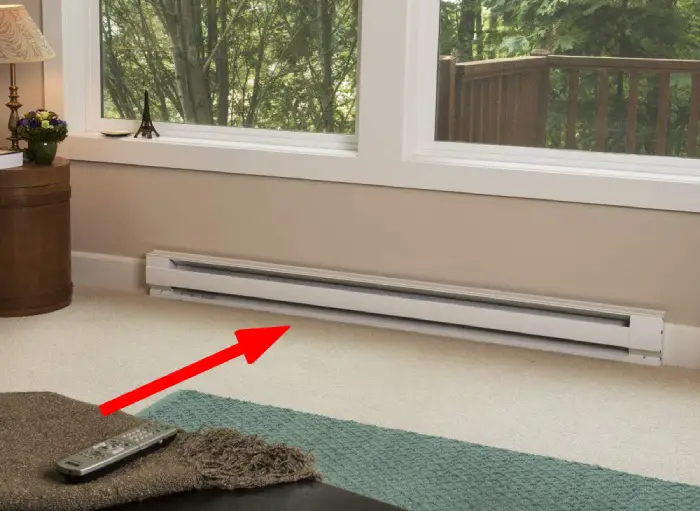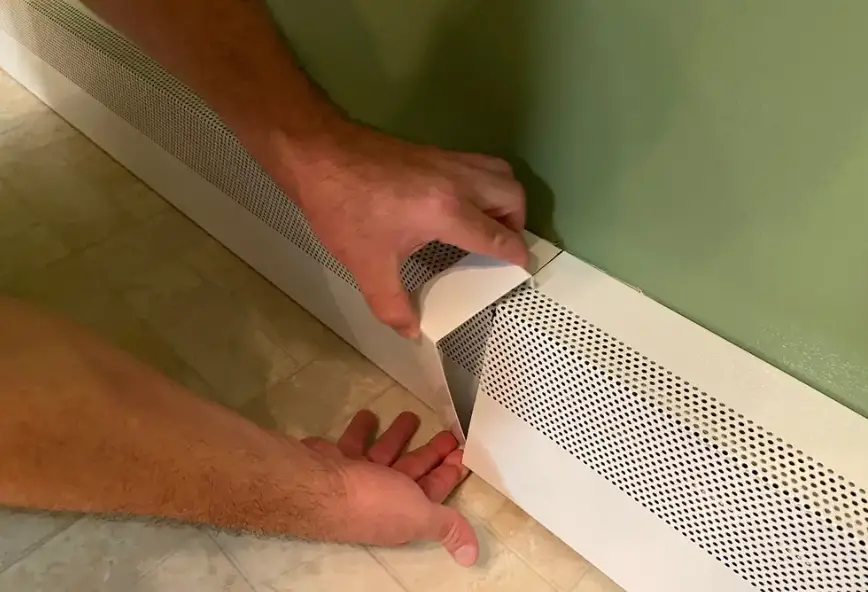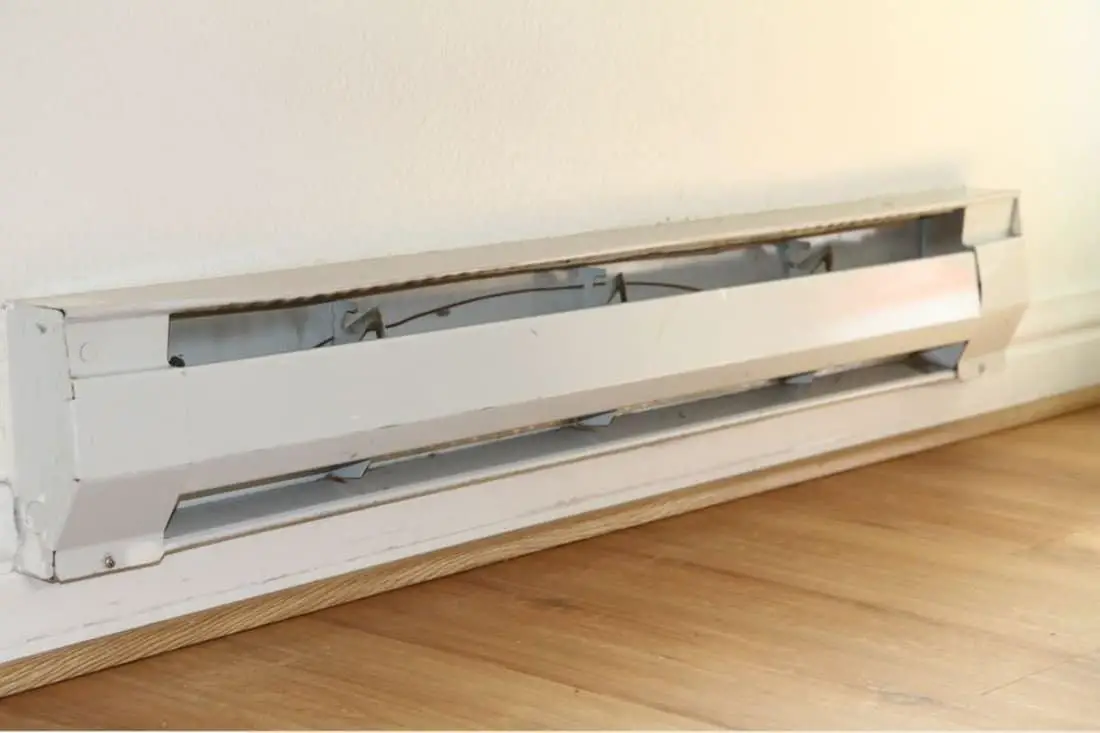Baseboard heating is a popular choice for many homeowners. It is efficient and can be tailored to fit your specific needs. In this blog post, we will discuss everything you need to know before installing baseboard heating in your home. We will cover the basics, such as what it is and how it works, as well as more advanced topics, like installation tips and troubleshooting. If you are considering adding baseboard heating to your home, make sure to read this post first!
What Is Baseboard Heating?
The most popular form of baseboard heating is the hydronic (hot water) system, which heats your property utilizing hydronic (hot water) coils or electric resistance coils. Baseboard heaters are typically placed along the base of an exterior wall in each room that you want to heat. [1]
How Does Baseboard Heating Work?
Baseboard heating works by circulating heated air through a system of ducts and into the rooms of your home. The air is then forced out of the ducts and into the room through vents located at the base of the walls.
The heated air then rises and circulates throughout the room, providing evenly distributed warmth. When the thermostat reaches the desired temperature, the baseboard heater will turn off until the temperature drops and the cycle begins again.
Types of Baseboard Heaters
Electric Baseboard Heaters
The most common type of baseboard heater is the electric baseboard heater. These heaters work by converting electrical energy into heat. Electric baseboard heaters are typically made from steel or aluminum and use either convection or radiation to transfer heat to the room.
Convection Baseboard Heaters
Convection baseboard heaters work by circulating air around the room using a fan. The air is then heated by the element inside the heater and circulated back into the room. Convection baseboard heaters are more efficient than radiation baseboard heaters, but they can be more expensive to purchase and install.

Radiation Baseboard Heaters
Radiation baseboard heaters work by emitting infrared waves that travel through the air and are absorbed by objects in the room. The heat from the objects is then transferred to the air, raising the temperature of the room. Radiation baseboard heaters are less expensive than convection baseboard heaters, but they are not as efficient and can be more difficult to install.
Hydronic Baseboard Heaters
Hydronic baseboard heaters work by circulating hot water through a series of pipes that run along the baseboards in a room. The water’s heat is then transmitted to the air, raising the temperature of the space. Hydronic baseboard heaters may have a higher upfront cost than electric baseboard heaters, but they are more efficient to run and can be easier to install. [2]
How Much Do Baseboard Heaters Cost?
Baseboard heaters are an affordable way to heat your home, with most models costing between $25 and $200. However, the cost of installation will vary depending on the size and number of units you need, as well as the type of home you have.
How to Install Baseboard Heaters?
Installing baseboard heaters is a relatively easy task that can be completed in just a few hours.

The first step is to determine the location of the heaters. It is important to choose a spot where the heaters will not be obstructed by furniture or other objects. Once the location has been determined, the next step is to mark the drilling holes. Drill holes should be placed at least 8 inches apart.
After the holes have been drilled, the next step is to insert the anchors. Anchors should be placed at least 2 inches from the edge of the hole. Next, insert the screws and tighten them until they are snug. Be careful not to overtighten the screws, as this could damage the electrical connections.
Finally, connect the wiring to the baseboard heaters. Make sure all connections are tight and secure before turning on the power. Test the heaters by turn them on and feeling for warmth. If everything is working properly, enjoy your new baseboard heaters!
How Long Do They Last?
Baseboard heaters are built to last for a long time. In fact, most have a lifespan of 20 to 30 years. This means that if you install baseboard heaters in your home, you can expect them to provide reliable heating for many years to come.
Pros of Baseboard Heaters
There are several reasons why you might choose to install baseboard heaters in your home instead of other types of heating systems. Some of the benefits of baseboard heaters include:
- They’re relatively inexpensive to install.
- Baseboard heaters are usually very energy-efficient, so you’ll save money on your heating bills.
- Unlike some other types of heating systems, baseboard heaters don’t require a lot of maintenance.
- Baseboard heaters can be used as a supplemental source of heat in addition to your main heating system, or they can be used as your sole source of heat.
- Baseboard heaters provide gentle, even heat that is comfortable for most people.
Cons of Baseboard Heaters
Before you install baseboard heaters in your home, there are a few potential drawbacks to keep in mind:
- Baseboard heaters can be noisy, so if you’re looking for a quiet heating system, this might not be the best option.
- Because they’re usually mounted on the wall, baseboard heaters can take up a lot of space in a room.
- Some people don’t like the way baseboard heaters look, and they may not fit with the aesthetic of your home.
- If you have young children or pets, you’ll need to make sure they don’t touch the heater since it can get very hot.
- Baseboard heaters can take a while to heat up a room, so if you’re looking for instant heat, this might not be the best option.
Overall, baseboard heaters have a lot of advantages and only a few disadvantages. If you’re looking for an energy-efficient way to heat your home, baseboard heaters are definitely worth considering. Just be sure to weigh all the pros and cons before making a final decision. [5]
Are They Safe?
As with any electrical device, baseboard heaters need to be properly installed and maintained to prevent any safety hazards. If you’re considering installing baseboard heaters in your home, it’s important to consult with a professional electrician to ensure that the job is done safely and correctly.
Are They Energy Efficient?

Baseboard heaters are generally very energy efficient, particularly when compared to other types of heating systems. Because they generate heat directly, they don’t lose any energy through ductwork or other types of distribution systems. Additionally, baseboard heaters are typically equipped with built-in thermostats that allow you to better control the temperature in your home, which can further help to reduce your energy usage and costs.
Of course, the actual energy efficiency of your baseboard heaters will depend on a number of factors, including the size and type of heater you choose, as well as how well insulated your home is. However, in general, baseboard heaters tend to be quite energy efficient and can help you save money on your heating bills.
FAQ
What do I need to know about baseboard heating?
Homeowners considering or currently using baseboard heating may have questions about the system. Here are some answers to common questions about baseboard heating.
What is baseboard heating?
Baseboard heating is a type of forced-air heating that uses electrical resistance to generate heat. The heat is then distributed through a series of metal fins or tubes called “baseboards.”

How does baseboard heating work?
Baseboard heating works by converting electrical energy into heat. The electrical current passes through a material that resists the flow of electricity, such as metal. This resistance causes the material to heat up, and the heat is then transferred to the surrounding air.
Is baseboard heating efficient?
Baseboard heating is generally considered to be a very efficient way to heat a home. The heat is distributed evenly and efficiently through the metal fins or tubes, and there is little wasted energy.
What are the benefits of baseboard heating?
Baseboard heating has several benefits that make it a popular choice for many homeowners. Some of the benefits of baseboard heating include:
- Efficient – Baseboard heating is very efficient, with little wasted energy.
- Even Heat Distribution – The heat from baseboard heating is distributed evenly throughout the room, making it more comfortable.
- Safe – Baseboard heating is safe to use and does not produce any harmful gasses or fumes.
What are the drawbacks of baseboard heating?
Baseboard heating does have some drawbacks that should be considered before installation. Some of the drawbacks of baseboard heating include:
- High Initial Cost – Baseboard heating can be more expensive to install than other types of heating, such as forced-air furnaces.
- Maintenance – Baseboard heaters require regular maintenance, such as cleaning and checking for leaks.
- Not Suitable for All Homes – Baseboard heating may not be suitable for all homes, depending on the layout and construction.
What are the different types of baseboard heating?
There are two main types of baseboard heating:
- Electric – Electric baseboard heaters use electrical resistance to generate heat.
- Hydronic – Hydronic baseboard heaters use hot water to generate heat. The hot water is circulated through a series of metal fins or tubes, and the heat is then transferred to the surrounding air.
What is the most efficient way to use baseboard heaters?
There are a few things to consider when determining the most efficient way to use baseboard heaters. The first is the size of the room. Baseboard heaters are most effective in smaller rooms or areas where there is little air movement. This is because the heat generated by the element is meant to rise and circulate around the room, and in larger spaces or areas with a lot of airflow, much of the heat can be lost before it has a chance to reach its intended target.
Another factor to consider is the insulation of the room. A well-insulated space will retain heat better than an inadequately insulated one, meaning that less energy will be needed to maintain a comfortable temperature.
Finally, it is important to think about the climate in which you live. If you live in an area with very cold winters, it may be necessary to use your baseboard heater for a longer period of time each day than if you lived in a milder climate. Conversely, if you live in a hot climate, you may only need to use your baseboard heater for a short period of time each day or not at all during the hottest months.
Can you put furniture in front of baseboard heaters?
If you have baseboard heating in your home, you may be wondering if it’s okay to put furniture in front of the heaters. After all, you don’t want to block the heat and make your home less comfortable. Here’s what you need to know: it’s generally safe to put furniture in front of baseboard heaters, as long as the furniture is not blocking the airflow. So, if you have a couch or chair that’s close to a heater, just make sure there’s enough space for air to circulate around it. Of course, you’ll want to avoid putting anything flammable too close to the heater (just in case). And, if you have young children or pets, you may want to keep them away from the heaters as well, just to be safe. Overall, though, as long as you take some basic precautions, it’s perfectly fine to put furniture in front of your baseboard heaters.
Is baseboard heat better than forced air?
There are a few things to consider when deciding if baseboard heat or forced air is better for your home. Baseboard heat is more efficient because it doesn’t rely on ductwork, which can leak and lose heat. Additionally, baseboard heaters provide targeted heating, so you’re not wasting energy heating areas of your home that you’re not using. Forced air systems, on the other hand, are typically less expensive to install and can be easier to maintain (since they only have one filter). Ultimately, the best type of heating system for your home depends on your specific needs and preferences.
Useful Video: Installing Electric Baseboard Heater. DIY
Conclusion
Baseboard heating is a great way to keep your home warm and comfortable during the colder months. However, before you install a baseboard heating system, there are a few things you should know. Make sure you understand how the system works and what types of maintenance it will require. That way, you can be sure that your new baseboard heater will work properly and efficiently for years to come.
Installing a baseboard heating system is a big investment. But with proper care and maintenance, your baseboard heater will last for many years to come. So if you’re looking for an efficient and cost-effective way to heat your home, consider installing a baseboard heating system. It could be the best decision you ever make.
Thanks for reading!
References
- https://homeclimates.com/blog/pros-and-cons-of-electric-baseboard-heat
- https://www.familyhandyman.com/article/types-of-baseboard-heaters/
- https://www.angi.com/articles/whats-it-cost-replace-baseboard-heaters.html
- https://www.thespruce.com/how-to-install-a-baseboard-heater-1152677
- https://www.johncflood.com/our-blog/2019/may/the-pros-and-cons-of-baseboard-heat/














Leave a Reply